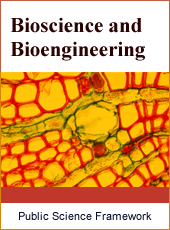Bioscience and Bioengineering
Articles Information
Bioscience and Bioengineering, Vol.4, No.4, Dec. 2018, Pub. Date: Dec. 21, 2018
Calcium Imaging with Super-Resolution Radial Fluctuations
Pages: 78-84 Views: 2346 Downloads: 857
[01]
Yuan-Hao Lee, Department of Ophthalmology and Visual Science, University of Texas Health Science Center at Houston, Houston, USA.
[02]
Shuo Zhang, Department of Ophthalmology, Emory University, School of Medicine, Atlanta, USA; Department of Ophthalmology, Xiangya Hospital, Central South University, Changsha, P. R. of China.
[03]
Cheryl Kyles Mitchell, Department of Ophthalmology and Visual Science, University of Texas Health Science Center at Houston, Houston, USA.
[04]
Ya-Ping Lin, Department of Ophthalmology and Visual Science, University of Texas Health Science Center at Houston, Houston, USA.
[05]
John O’Brien, Department of Ophthalmology and Visual Science, University of Texas Health Science Center at Houston, Houston, USA; The MD Anderson Cancer Center, UTHealth Graduate School of Biomedical Sciences, Houston, USA.
Calcium signals act as a ubiquitous secondary messenger in regulating many body functions. The detection of calcium microdomain signals is greatly facilitated by the existence of biomarker-targeted fluorescent probes. In this study, SRRF (super-resolution radial fluctuations) algorithm were used to compare the loci and the intensity of fluorescent probes before and after SRRF analysis. The implementation of SRRF algorithm was aimed for automatically resolving delicate and small calcium signals (to avoid the overlapped loci) on original images. For assessing the spatial accuracy of image intensity, immunofluorescence staining of retina cryostat slice for connexin 36 (Cx36) was microscopically imaged with or without the successive SRRF reconstruction. For characterizing the temporal association between SRRF and non-SRRF images, the changes of Cx36-GCaMP calcium indicator were recorded from transfected HeLa cells in response to the transient puffing of ionomycin. Image processing and analyses were conducted with Image J and Matlab. Through this study, SRRF reconstruction was found to confer an accurate measure for the identification of subcellular molecules, such as gap junctions. Compared with the conventional imaging, SRRF reconstruction generated better image resolution for the precise registration of individual signals. Temporally, the ratios of change in fluorescence intensity between SRRF and non-SRRF images were significantly correlated in the presence or absence of the subtraction of high background intensity. Quantitatively, the ratios of change in fluorescence intensity between SRRF and non-SRRF images with or without background subtraction were also significantly correlated. The merit of SRRF application on calcium live imaging was validated with the reporter gene system we worked on.
Calcium Signals, SRRF, Image Resolution
[01]
Russell, J. T. (2011). Imaging calcium signals in vivo: A powerful tool in physiology and pharmacology. Br. J. Pharmacol., 163 (8), 1605-1625.
[02]
Ellefsen, K. L., Settle, B., Parker, I. and Smith, I. F. (2014). An algorithm for automated detection, localization and measurement of local calcium signals from camera-based imaging. Cell Calcium., 56 (3), 147-156.
[03]
Culley, S., Tosheva, K. L., Matos Pereira, P. and Henriques, R. (2018). Srrf: Universal live-cell super-resolution microscopy. Int. J. Biochem. Cell Biol., 101, 74-79.
[04]
Gustafsson, N., Culley, S., Ashdown, G., Owen, D. M., Pereira, P. M. and Henriques, R. (2016). Fast Live cell conventional fluorophore nanoscopy with Imagej through super-resolution radial fluctuations. Nat. Commun., 7, 12471.
[05]
Nakai, J., Ohkura M. and Imoto, K. (2001). A high signal-to-noise Ca(2+) probe composed of a single green fluorescent protein. Nat. Biotechnol., 19 (2), 137-141.
[06]
Wang, Q., Shui, B., Kotlikoff, M. I. and Sondermann, H. (2008). Structural basis for calcium sensing by Gcamp 2. Structure, 16 (12), 1817-1827.
[07]
Akerboom, J., Rivera, J. D., Guilbe, M. M., Malave, E. C., Hernandez, H. H., Tian, L., Hires, S. A., Marvin, J. S., Looger, L. L. and Schreiter, E. R. (2009). Crystal structures of the Gcamp calcium sensor reveal the mechanism of fluorescence signal change and aid rational design. J. Biol. Chem., 284 (10), 6455-6464.
[08]
Li, H., Zhang, Z., Blackburn, M. R., Wang, S. W., Ribelayga, C. P. and O’Brien, J. (2012). Adenosine and dopamine receptors coregulate photoreceptor coupling via gap junction phosphorylation in mouse retina. J. Neurosci., 33 (7), 3135-3150.
[09]
Wang, H. Y., Lin, Y.-P., Mitchell, C. K., Ram, S. and O’Brien J (2015). Two-color fluorescence analysis of connexin 36 turnover: Relationship to functional plasticity. J. Cell Sci., 128, 3888-3897.
[10]
Tian, L., Hires, S. A., Mao, T., Huber, D., Chiappe, M. E., Chalasani, S. H., Petreanu, L., Akerboom, J., McKinney, S. A., Schreiter, E. R., Bargmann, C. I., Jayaraman, V., Svoboda, K. and Looger, L. L. (2009). Imaging neural activity in worms, flies and mice with improved GCaMP calcium indicators. Nat. Methods, 6 (12), 875-881.
[11]
Ready, J. “Optical Detector and Human Vision,” in Fundamentals of Photonics, NY: Wiley, 1991.
[12]
Hasinoff, S. W. “Photon, Poisson noise,” Computer Vision. A Reference Guide, Springer Science Business Media New York, 2014.

ISSN Print: 2381-7690
ISSN Online: 2381-7704
Current Issue:
Vol. 6, Issue 3, September Submit a Manuscript Join Editorial Board Join Reviewer Team
ISSN Online: 2381-7704
Current Issue:
Vol. 6, Issue 3, September Submit a Manuscript Join Editorial Board Join Reviewer Team
| About This Journal |
| All Issues |
| Open Access |
| Indexing |
| Payment Information |
| Author Guidelines |
| Review Process |
| Publication Ethics |
| Editorial Board |
| Peer Reviewers |


